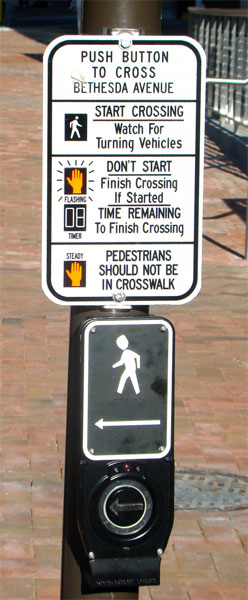You don’t have to push this button to cross the street
If you walk to a corner and see a button to activate the walk signal, you might need to push it. Or you might not. It might only be there to activate a chirping noise for people with vision impairments. Unfortunately, there’s no way to tell.
Some intersections keep “don’t walk” signals lit during both red and green phases of a traffic light unless someone pushes a “beg button” — technically an “actuated pedestrian push button” — before the light turns green.
The sign on the picture above clearly implies that that’s what will happen when people wanting to cross the street push the button.
But the button actually has nothing to do with the walk signal. The walk signal comes on whether you press the button or not.
What the button does is turn on a loud chirping noise that speeds up when the walk signal begins. The misleading signs have appeared in large numbers in DC, Montgomery County, and elsewhere over the past year, on local roads and state highways.

Unless you can’t see the sign, pushing this button won’t help you cross Bethesda Avenue. Photo by the author.
Why is this?
Federal guidelines, known as the Manual on Uniform Traffic Control Devices (MUTCD), authorize only certain standard signs for pedestrians. Among them are several variants for buttons that control the walk signal, but no sign for buttons that merely activate the audible signal for people with visual impairments.
In downtown Bethesda, chirper buttons have appeared in large numbers over the last half year, all accompanied by the standard sign. Frequent passers-by soon recognized that the sign conveyed a falsehood, and now, few people push the button.
From my observation, it has become more common for people to simply cross streets wherever and whenever they feel safe. The streets seem no less safe.
Highway agencies take great care to ensure that signs meant for drivers are accurate and unambiguous — and doing so helps keep all who use the roads safe. Pedestrians, as these pushbutton signs illustrate, get very different treatment.
By taking such a nonchalant attitude toward those on foot, traffic engineers implicitly recognize something their profession refuses to officially admit: Drivers in the wrong place endanger others, but pedestrians do not.


